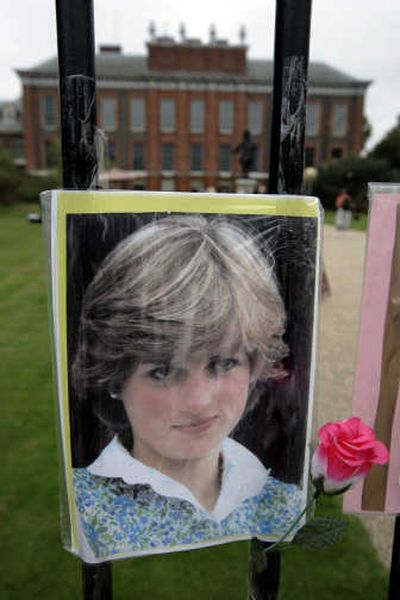A decade without Diana

LONDON – The mounds of flowers are long gone from the gates of Kensington Palace, but Princess Diana’s presence lingers.
It has been 10 years since Diana’s death in a Paris car crash, a day when many Britons were poleaxed by grief for a vivacious and troubled woman who was at once style icon, charity worker and tabloid celebrity.
The anniversary will be marked today by a televised memorial service, special prayers – and soul-searching in a country still unsure whether its sudden outpouring of emotion was a moment of madness or a fundamental softening of the stiff upper lip.
“A decade on,” columnist Jonathan Freedland wrote in The Guardian newspaper, “we look back and wonder what came over us.”
Diana, 36, and her boyfriend Dodi Fayed, 42, were killed along with chauffeur Henri Paul when their car crashed in a Paris tunnel on Aug. 31, 1997.
French and British investigations concluded Paul was drunk and lost control of the car while trying to evade photographers. But Fayed’s father, Mohamed al Fayed, insists Diana and his son were murdered at the behest of the royal family. A British coroner’s inquest is unlikely to end the debate.
In the days that followed, an estimated 1 million bouquets were left outside Diana’s Kensington Palace home and more than a million people lined the route of her funeral procession. Newspapers exhorted the royal family to return from Scotland and make a display of mourning.
It’s a period re-created in the film “The Queen,” in which newly elected Prime Minister Tony Blair gently guides Helen Mirren’s monarch through the eddies of emotion for the woman he called “the people’s princess.”
“People thought they knew her because she shared her thoughts and feelings, which no one in her position had ever done before,” says Ingrid Seward, author of “The Queen and Di: The Untold Story.”
In grieving for Diana, Seward adds, “people were mourning some aspect of themselves.”
When she died, Diana was the world’s most famous woman. She had married Prince Charles, the heir to the British throne, in a 1981 ceremony that was televised around the world. They had two sons, William and Harry, but divorced in 1996 after admissions of adultery on both sides.
“She and the Prince of Wales could have been the best double act the country has ever had,” says Ken Wharfe, Diana’s Scotland Yard bodyguard between 1986 and 1993. “But it didn’t work out.”
The rest of Diana’s life was divided between her sons and charity work – for people with AIDS, sick children, land mine victims. All the while, she made frequent appearances on newspaper front pages and gossip columns.
Attempts to commemorate Diana have been troubled. A memorial fountain in Hyde Park was opened by Queen Elizabeth II in 2004, but shut to the public the next day after flooding and had to undergo months of renovation.
Today’s official observance will be somber and subdued: a memorial service for friends and family at the Guards Chapel in London’s Wellington Barracks. Diana’s sons are officers in an army regiment, the Household Cavalry.
Diana-philes will leave a wreath outside the palace, as they do every year.
“We intend to keep her memory alive, and we intend she is given her proper place in the annals of history,” says Margaret Funnell of the Diana Circle, a dedicated group of fans.
Diana’s legacy is hotly debated. Some see a narcissist who courted media attention. Others recall a warm, generous woman who focused her energy on charitable causes and dared to hug AIDS victims.
“Diana was ahead of her time,” says Wharfe, the former bodyguard. “When she took on the challenge of dealing with AIDS, it was a real problem for the royal family. I remember the queen saying, ‘Why do you get involved in all these nasty things? Why don’t you do something nice?’ “
In prayers written for the memorial service, Archbishop of Canterbury Rowan Williams said Diana’s “vulnerability and her willingness to reach out to the excluded and forgotten touched us all; her generosity gave hope and joy to many.”
Royal biographer Seward says Diana’s image has improved with time, her good works outshining her messy love life.
“It’s the opposite of (Shakespeare’s) ‘Julius Caesar’ – ‘The evil that men do lives after them.’ The good she did lives after her, which is appropriate for an icon,” Seward says.
Diana’s most enduring legacy may be her impact on the monarchy, which was widely viewed as stiff and aloof just after her death but took steps to appear warmer.
Princes William and Harry, dressed in jeans and dancing as they hosted a rock concert in their mother’s honor last month, are symbols of the shift.
“I think they are back on a solid footing,” Seward says of the royals. “They may be a little duller, but they’re there.”